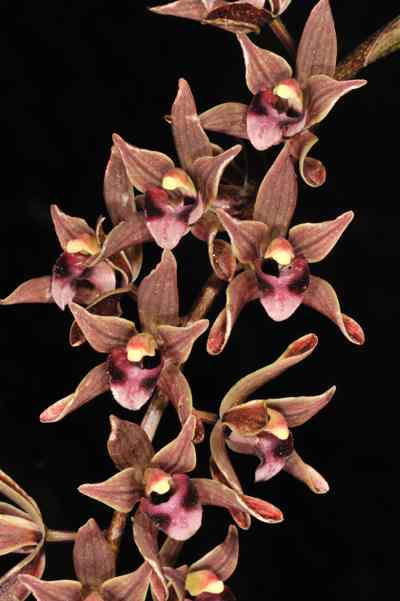Terrestrial. A small plant with 3 to 5 elliptic-oblong leaves. Leaves 6 to 12 cm in length and 3 to 5 cm at its centre, acute, minutely bifid at its apex, fleshy, sheathing to its base, shades of green reticulated with pale green above and dull brown below. Peduncle longer than the leaves, terete, puberulosus, with solitary erect flowers, very rarely found with two flowers also (of around 80 plants I found from the region, only three specimens were having two flowers). Flowers 3 to 5 cm across, floral bract oblong, acute and tubular. Dorsal sepal erect, white with bright green converging concave stripes, with a few broken half way; the lateral pair brownish pink. Sepals bright green with pinkish brown tips, with green veins and few irregular dark purple spots. Lip is yellowish green shaded with pale pink and networked with green.

The Pursuit
The most thrilling and fascinating flower hunt of my life was for this species. This species is brought from neighbouring states in plenty and also collected from the region in large scales for commercial purposes for decades. Thus making it available in every house of the region, but very rarely found in its natural habitat. However, my desire to study the plant from its natural habitat took me twice to a deep forest which is one of the most isolated places of the Eastern Himalayas. I did good research on the habitat of this species from several referral books and information from various geographical database and undertook a journey of over 20 km through a narrow stream with vertical hills on both sides. The route was through the dense forests of the region with regular sightings of herds of elephants and leopards. The walk was against the flow of the stream with regular small but steep water falls all the way, 82 of them in total. The blooming time of the species was mentioned as February and March, so decided to make the trip in the mid of January. The temperature even at those low altitudes go down to 6 to 8C in the month of January, not to mention about the coldness of the flowing water in the stream. The whole journey of around 20 km was through that cold stream, with knee to waist deep water. The more I walked ahead the narrower the stream became, the narrower the stream the faster the flow of water. Each step was to be set with maximum alertness. By the half way, I understood this journey is like landing on the Moon, “no rescue at all”!!!. After 8 hours of tedious walk through waist high cold flowing waters, we reached the location I was searching for. My friend who came along helped me with fixing the tent and in cooking the dinner. In those winter months the days are very short in the Himalayas, it will be pitch-dark around 4:30 PM. Rested inside the tent with a camp fire in front of the tent to ward off wild animals. We both were so tired, but were deprived of sleep due to our wet feet and chilled body. Spend the whole night with headphones active. Next day, searched the whole area and we were blessed to find more than 80 plants of the species in buds. It was a wonderful moment to find such a rare species in its natural habitat, that also in abundance. I was really happy that a meticulous research on its location was proved right. Returned that afternoon with great pride. Hid the tent and few utensils we carried underneath few rocks, so as to avoid carrying them back and forth again in a few day’s of re-visit. The return was more memorable, sighting a herd of elephants, seventeen of them, blocking our way. It was a real photo shoot time for me, for around 3 continuous hours – nonstop!!!. However, I missed my 300mm/2.8 lens. By sunset those wild friends retired to their dense forest homes and we took the left over return journey under darkness, with several nosedives and tumbles. Luckily I had my camera equipments packed in water proof packs. Reached the village after 8 PM only to surprise the sleepy villagers. Again undertook the same thrilling journey in the first week of February for this wonderful photograph.








